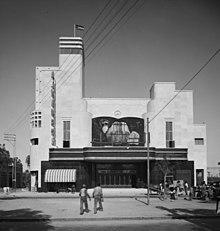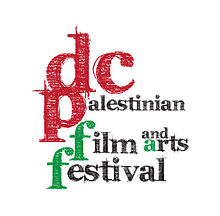Cinema of Palestine
Following this documentary, Sirhan joined Jamal al-Asphar to produce a 45-minute film called The Realized Dreams, aiming to "promote the orphans' cause".Sirhan and al-Asphar also produced a documentary about Ahmad Hilmi Pasha, a member of the Higher Arab Commission.Only one dramatic movie was made during the period, namely Return to Haifa in 1982, an adaptation of a short novel by Ghassan Kanafani.In 1982, when the PLO was forced out of Beirut, the archive was put into storage (in the Red Crescenty Hospital), from where it "disappeared" under circumstances which are still unclear.[20] Notable film directors of this period include[21] Michel Khleifi, Rashid Masharawi, Ali Nassar and Elia Suleiman.[25] In contrast to the way some other locations with associations to film industry are named in casual parlance, the term Pallywood has only derogatory acceptions.



PallywoodscreensPalestiniansDemographicsDefinitionsPalestineHistoryPeopleOriginDiasporaArab Higher CommitteeDepopulated villagesAll-Palestine ProtectorateGovernmentFedayeen militiasNational Authority (PNA)political partiesIslamic JihadPolitics of the Palestinian National AuthorityEnclavesGovernoratesCitiesGaza Strip governance (Hamas)Governorates of the Gaza StripNational Council (PNC)Legislative Council (PLC)West BankGaza StripEast JerusalemChristianityJudaismAl-AqsaCave of the PatriarchsChurch of the Holy SepulchreChurch of the NativityDome of the RockGreat Mosque of GazaJoseph's TombNabi SamwilRachel's TombCultureCostume and embroideryCuisineDabke (dance)HandicraftsLanguageLiteratureList of PalestiniansPalestinianArabicEnglishFrenchHalhulIbn Saud of Saudi ArabiaMandatory PalestineTel Avivsilent movieNabi Rubin festivalsAhmad Hilmi PashaHigher Arab Commission1948 Palestinian expulsion and flightBaghdadMustafa Abu AliBeirutGhassan KanafaniarchivesIsrael Defense ForcesTel HaShomercomedyChronicle of a DisappearanceSeattle International Film FestivalLuigi De LaurentiisVenice Film FestivalMichel KhleifiRashid MasharawiAli NassarElia SuleimanCinema JeninCannes Film FestivalNetflixlocations with associations to film industryEmad BurnatHany Abu-AssadAzza El-HassanMahdi FleifelScandar CoptiMohammed BakriTarek Al EryanAnnemarie JacirMai MasriMontaser MaraiRosalind NashashibiFarah NabulsiLeila SansourSameh ZoabiAmeen NayfehNajwa NajjarHisham ZreiqList of Palestinian filmsWedding in GalileeDivine InterventionOlive Harvest, TheArna's ChildrenJeremy Hardy vs. the Israeli ArmyParadise NowGolden Globe for Best Foreign Language FilmThe Color of OlivesIron WallFirst PictureThe Sons of EilabounDubai International Film FestivalCairo International TV and Media FestivalSalt of this SeaMiddle East International Film FestivalThe PresentAcademy AwardBAFTA AwardThe TeacherGalway Film FleadhSan Francisco International Film FestivalBrooklyn Film FestivalKosmoramaNo Other Land74th Berlin International Film FestivalDC Palestinian Film and Arts FestivalAl Ard Film Festival (Cagliari, Sardinia)